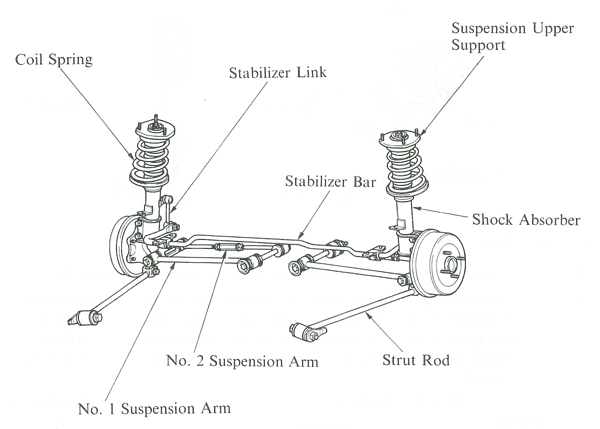Car is a 2000 Corolla. We know the “front wheel” is held by wheel bearing, ball joint, control arm. What is the “rear wheel” held by? Does it also have a wheel bearing?
Here’s a diagram of the rear suspension for a '93, yours is probably similar. And yes, all wheels have bearings of some sort:

So if the wheel bearing fails for the rear wheel…can the wheel come off?
yes but theyll always make noise or shake before they get that bad
@xaml - Why do you ask?
I was just wondering. I thought only the front wheels needed wheel bearings as they connect to axles that spin.
Dont know why the rears need wheel bearings too…the wheels don’t turn…only spin.
How do you think they spin? Something’s got to handle that. The ‘turning’ part doesn’t require bearings, anyway.
In addition to what texases stated, I think that it is necessary for the OP to understand the role of wheel bearings.
Among other things, the bearings are there to eliminate as much friction as possible when the wheels “spin”.
If there were no wheel bearings, or if the bearings went dry, the amount of energy required to spin the wheels would be…massive.
And, incidentally, when wheel bearings go so dry that they “seize”, the effect is the same as slamming on the brakes on just one wheel. And then, of course, there is that thing about a wheel flying off. That could be particularly unpleasant at highway speeds.
I see, so is the 100% sure way (or close to it) to check for bad wheel bearings is to check for play horizontal and vertical by pulling on the tire? (besides the rumbling noise)
The noise will typically start w-a-y before any noticeable play can be seen by pulling on the wheel/tire assembly…
“I see, so is the 100% sure way (or close to it) to check for bad wheel bearings is to check for play horizontal and vertical by pulling on the tire? (besides the rumbling noise)”
Nope. You should also turn the wheel by hand feeling for any roughness. Sometimes you can feel roughness in the bearing by turning the hob by hand without the wheel on. The wheel’s mass can dampen the roughness.
Bearings do not hold wheels on. They only reduce friction between stationary surfaces and spinning surfaces. Since car wheels must support large loads and withstand even larger forces from impact, only steel will work, and rubbing steel against steel at high speeds under many hundreds of pounds of load would result in instant failure without bearings. .
There are basically three types of bearings in automobiles; sleeve bearings, roller bearings, and ball bearings. Each has advantages and disadvantages.
Sleeve bearings, used for crankshafts, connecting rods, and camshafts, are like the sleeves on a formal dress shirt. But to reduce friction, oil is forced under pressure to provide a pressurized fluid barrier between the metal surfaces. Since it would be impractical to provide pressurized oil to the four axles, that isn’t used.
Roller bearings, used in older wheels, are just rollers that allow the wheel to spin on the axles without excessive friction. With grease, which in the old days we used to occasionally replenish, they allow high speeds and large impact loads.
Ball bearings replace roller bearings in modern cars because they have lower rolling resistance. But they have far smaller contact areas than rollers, and forces are more concentrated. As a consequence, we have to replace wheel bearings on modern cars far more often than we did on old cars.
I’ve attached a link to a drawing of your rear axle and hub assembly. If you have a bad rear bearing, you’ll need to replace the entire hub & bearing assembly. These bearings are not user-serviceable. The information in the link will give you everything you need to order the assemblies. I urge you to also find instructions, via a repair manual or the internet.
http://www.toyotapartsoverstock.com/showAssembly.aspx?ukey_product=4138377&ukey_assembly=518976
Thanks for the great info.
@XAML Even your bicycle, when you were a kid, had wheel bearings! Both front and rear wheel. Even though the rear wheel drove the bike.
As explained, all rotating items, from your mother’s mixer, to the washing machine and drier need bearings. As explained, without bearings, these rotating items would get very hot and wear out quickly.
Only items that rotate very slowly and infrequently, and have little load, can get by with just a joint without bearings.
All wheels that I can think of need bearings of some sort, even if it’s just a plastic or metal sleeve.
@Docnick; overlooked one. Even the yoke below the handlebars has bearings. So not only the fast rotating parts, but the parts that carry a lot of weight.
Yosemite
don t forget needle bearings in universal joints…
Darn. I knew I forgot something…
The pedals have bearings too. Boy are memories coming back. Ball bearing falling out of the race, falling on the dirt . . .
As do the bottom brackets.
Bearings are everywhere.
there is one stupid bearing where the rod that the gas pedal connects to goes thru the firewall in my 75 ford truck. my original went bad and my gas pedal would stick sometimes and I would have to lift it with my toe. I had a parts truck and I replaced the pedal assembly which worked for a year or so. now it is starting to stick too. I put an extra spring on my throttle which helps but did not completely solve the problem.
I don t think I can get that part, tho I have not checked. looks like another spring is in my throttles future…